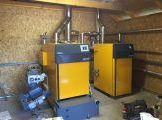Biomass Policy, Facts and Figures

Biomass Policy, Facts and Figures
This section provides an overview of Scottish and UK policy relating to biomass and the key facts and figures of the sector:
- Scottish Policy Context
- 2017 Scottish energy strategy
- UK Policy
- Installed biomass systems in Scotland
- Biomass use in Scotland – facts and figures
- Global and European biomass facts and figures
Scottish Policy Context
2009 Climate Change (Scotland) Act
The Scottish Parliament set Scotland’s ambitious climate change targets:
- 80% reduction in greenhouse gas emissions by 2050.
- By 2020 11% of non-electrical heat demand is delivered from renewable sources.
- Click here for more information on the 2009 Climate Change Act.
2019 Climate Change (Emissions Reduction Targets) (Scotland) Act
The 2009 Climate Change Act was amended by this act, to make provision setting targets including to be net-zero by 2045. In 2020, 6.4% of renewable heat produced in Scotland came from renewable sources(Renewable heat in Scotland, Energy Saving Trust 2020), with 70% of this coming from biomass – emphasizing the pertinence of the fuel source in the drive to net-zero. Read more on the bill and the emissions targets here.
Heat Policy Statement – 2015
The Scottish Government’s most recent Heat Policy Statement was published in 2015 and acknowledged heat is at the core of Scotland’s energy system. The Statement notes heat is:
“…. the biggest element of our energy use (over 55%), and the largest source of our emissions (47%). We spend £2.6 billion annually on heating and cooling our homes and businesses in Scotland. The Scottish renewable heat sector is growing with an estimated turnover of £2.7 billion by 2020.”
If the 2020 Scottish renewable heat target is going to be met (11% of non-electrical heat demand from renewable sources) then 6,420GWh of renewable heat output are needed by that date. The Government recognise that this target remains challenging.
If the biomass heat sector constitutes the same proportion of our renewable heat in 2020 as now and we meet the 11% target; then we calculate an additional 2,000GWh of biomass output must be provided by 2020. Nationally that means 768MW of new biomass capacity must be added, representing hundreds of millions of pounds of capital investment and a massive growth in the fuel supply chain(Renewable Heat in Scotland, Energy Savings Trust, 2015).











